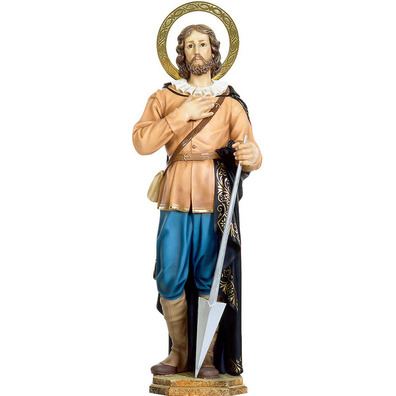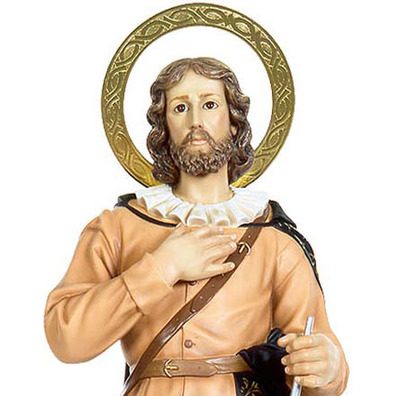San Isidro Labrador, patron saint of Madrid
224,00€
Taxes includedReligious product available on request . Shipping time is approximately 6-10 weeks. For more information about this product, contact to Brabander catholic products.
Image of San Isidro Labrador, patron saint of Madrid
- Image made by hand.
- Made of pulp wood.
- Polychrome finish.
- Sale price includes golden metal halo.
- Image of San Isidro for sale in 20, 30, 40, 50, 60, 80, 100, 120, 140 and 160 cm.
- Cristal eyes.
- For sale other images of San Isidro Patron of Madrid .
- San Isidro is represented with his right hand on his chest and in his left hand the share of a hand plow.
- San Isidro is dressed in clothing typical of the ancient peasants of Castile: a tunic with buttons that adjusted it to the chest, short breeches, wide leggings closed at the knee, and a jacket collar decorated with a lechuguilla.
San Isidro Labrador, life of a Saint
San Isidro, whose name was Isidro de Merlo y Quintana, was born in the city of Madrid. He came from a family of farmers and continued the family tradition by dedicating himself to the countryside and its cultivation as a servant of Don Iván de Vargas, nobleman and gentleman of one of the cleanest lineages in Madrid, the Vargas.
San Isidro was born in the town of Madrid around the year 1075 under the government of Alfonso el Bravo, king of Castile, León and Galicia. His life will be long and prosperous in deeds and miracles with which he gains great devotion from the people. This, together with his immense Christian charity and a humble life dedicated to the countryside, made him worthy of being the patron saint of peasants and farmers and of his hometown, Madrid. Being his day of celebration on May 15.
Historians believe that he was baptized in the church of San Andrés, and spent his childhood years in Madrid, where he frequently visited Nuestra Señora de la Almudena. In his youth he moved to Torrelaguna, a city near Madrid, where he met his wife María de la Piedad, a woman who came from Uceda (Guadalajara). Mary will also be venerated on altars as Santa María de la Cabeza.
It is in these years that his relationship with water and fountains begins, carving out a great fame as a dowser.
Approximately in the year 1109, Iván de Vargas asks San Isidro to move back to the town of Madrid where the Madrid gentleman had large possessions. San Isidro, already married, agrees and stays with his wife in one of his lord's homes, next to the church of San Andrés.
After years of remarkable work, San Isidro died at his home in Madrid at an age close to ninety.
After the death of San Isidro in the town of Madrid , his incorrupt body rested in various dwellings. At first, the saint rests in the Church of San Andrés. Already in the fifteenth century a chapel dedicated to San Isidro was built in the same city of Madrid and his remains were transferred there. Finally, the body was transferred to the Royal Church of San Isidro in Madrid, where it currently rests.
Saint Isidore was beatified by Paul V on June 14, 1619 and canonized on March 12, 1622 by Gregory XV, together with Saint Philip Neri, Saint Teresa of Jesus, Saint Ignatius of Loyola and Saint Francis Javier, although the bull of canonization it was not published until 1724 by Benedict XIII.
San Isidro Labrador, miracles
The miracles attributed to the patron saint of Madrid are many and varied. It should be noted that most of them are related to water and springs, elements that would always be present throughout their lives.
One of the most notable miracles occurred during a year when an extreme drought hit the fields of Madrid. San Isidro, fearing for his lord's crops, struck the earth with his hazadón, causing a spring to sprout in the crops. It is said that the abundance of water was such that it supplied the entire city of Madrid. It is this same spring that cured King Philip III of a very serious illness.
Tradition has it that due to his great work in the field, a large number of envious people arose who dedicated themselves to slandering him before his lord. Don Iván de Vargas, willing to know the truth, went to the Madrid fields where San Isidro carried out his work. The gentleman saw that San Isidro works tirelessly, except for the few moments he dedicated to praying. Even in these moments of prayer, the oxen continued to make furrows in the field guided by heavenly angels.
The story also tells us about his immense charity and love for nature through his experiences during the day, such as when sowing wheat he threw some grains of seed out of the furrow so that the birds and ants could feed "For all his Divine Majesty". Or when the boss of Madrid went to the mill where he had to grind the harvested wheat, he gave most of the cereal to the poor he met along the way.
San Isidro Labrador, festivity on May 15
May 15 is his feast day since it was on this day that the people of Madrid learned that His Holiness had beatified San Isidro.
In Madrid, the birthplace of San Isidro , a pilgrimage is celebrated around the hermitage erected in his honor in the Pradera de San Isidro, next to the Manzanares River in the District of Carabanchel. One of the most important bullfights in the world, the San Isidro Fair, has also been held in his name since 1947.
The festival of San Isidro is not exclusive to Madrid , throughout the Spanish geography many other locations celebrate this great Christian Saint such as Tenerife, with special relevance the celebration of Los Realejos, in numerous Andalusian towns, in Yecla, in Dueñas , etc...
Home delivery of religious images and articles in Madrid .






